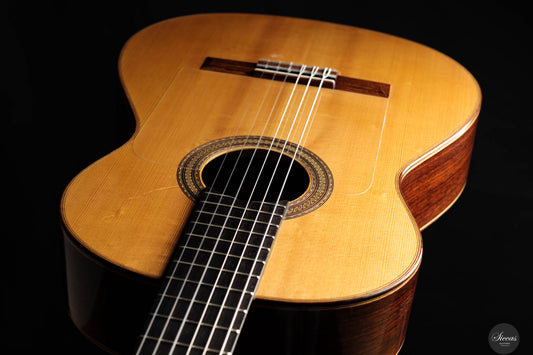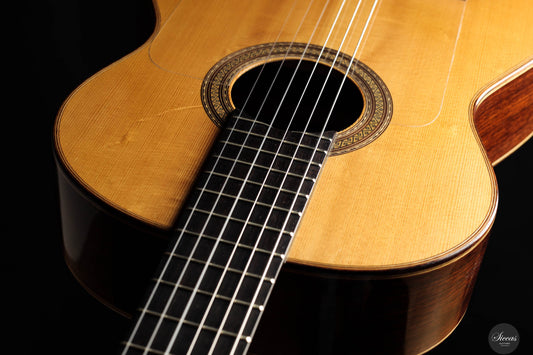Flamenco
-
Jose Marin Plazuelo - 2010 - Flamenca Negra No. 681
Price: $8,249Sale price $8,249 Price:Unit price per Tax free (0% BM)$0Save: $-8,249Luthier: Jose Marin PlazueloConstruction Type: FlamencoConstruction Type: Traditional
You may also be interested in about Flamenco
Flamenco Guitars
“Flamenco” refers to a distinctive genre of music and dance originating from Andalusia in Spain. The musical accompaniment for the songs and dances traditionally involves clapping (“palmas” or palm-clapping), castanets, and the guitar.
How do Flamenco Guitars Differ from Classical Guitars?
Flamenco guitars have narrower sides and are built lighter than classical guitars. The overall shape is more or less the same. The space between the strings and the fingerboard, as well as the top, is much flatter. This design allows for the easy execution of rapid runs, commonly found in flamenco. A light touch on the frets is permitted, emphasizing the percussive nature of the music. The lightweight construction contributes to a faster and more pronounced sound. Originally, the strings were attached to pegs that were inserted through the headstock, akin to string instruments. However, modern flamenco guitars typically use standard tuning machines, making tuning easier and more precise.
A distinctive feature often found on the top of a flamenco guitar is the “golpeador” or tap plate. It’s a transparent, self-adhesive protector that shields the top from finger strikes. The golpeador is named after the Spanish word “golpe,” meaning “strike,” and refers to a percussive playing technique common in flamenco where the top is tapped rhythmically with the fingernails and fingertips to create a percussive sound. Once attached, the golpeador is barely visible and helps prolong the guitar’s lifespan. The sound quality of the guitar is practically unaffected by the presence of a golpeador.
What Woods are Used in Making Flamenco Guitars?
Traditionally, the body of a flamenco guitar is crafted from cypress or rosewood, and the top is made from spruce (referred to as “Flamenco Negras”). Paco de Lucía, arguably the most famous flamenco guitarist of all time, desired a slightly more powerful and louder flamenco guitar. This significantly transformed the flamenco guitar.
Most Spanish guitar makers also create flamenco guitars, with Conde Hermanos being one of the most renowned, having crafted guitars for Paco de Lucía.
Flamenco Guitar Playing Technique
Flamenco playing technique is distinct from classical guitar. Players adopt a different posture, strumming patterns, and techniques. Flamenco guitarists are known as “tocaores,” and the flamenco guitar technique is referred to as “toque.”
Flamenco players tend to position the guitar between the soundhole and the bridge, but closer to the bridge to produce a rougher, scratchy tonal quality. Unlike classical “tirando” technique, flamenco technique involves “apoyando” where the strings are struck towards the soundboard in a way that the striking finger is supported by the adjacent string. This sometimes results in the vibrating string lightly touching the frets along its length, creating a percussive effect.
While classical guitarists support the guitar on the left leg and tilt it, flamenco guitarists typically cross their legs and support the guitar on the top leg, with the guitar neck nearly parallel to the ground. This different position suits various playing techniques. Many tremolo, golpe, and rasgueado techniques are easier and more relaxed when the upper right arm is supported by the guitar body at the elbow rather than by the forearm, as in classical guitar. Nonetheless, some flamenco guitarists adopt the classical position.
Flamenco is usually played using a capo, known as “cejilla,” which raises the pitch and imparts a sharper and more percussive sound to the guitar. However, the main purpose of using a capo is to change the guitar’s key to match the singer’s vocal range. As flamenco is an improvised music form that employs general structures and chord progressions, the capo makes it easier for players who haven’t played together before to do so. Instead of transcribing into different keys every time the singer changes, the player can move the capo and use the same chord positions. Flamenco employs heavily modified and open chord forms to create a solid drone effect and leaves at least one finger free to add melodic notes and movement. Very little traditional flamenco music is written down; rather, it’s passed down orally. However, books are becoming more available.
Both accompaniment and solo flamenco guitar are based on both modal and tonal harmonies; often, both are combined.
Why Shop at Siccas Guitars?
Our range of flamenco guitars reflects quality and value. As guitar craftsmen, we prioritize excellent sound and craftsmanship over brand names alone. Moreover, all our guitars are fine-tuned in our master workshop to ensure optimal playability.
Visit our store and experience the magic of flamenco with our top-notch guitars.



